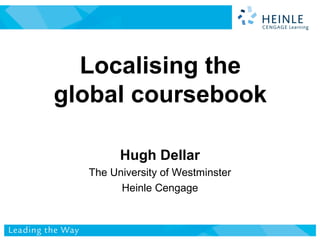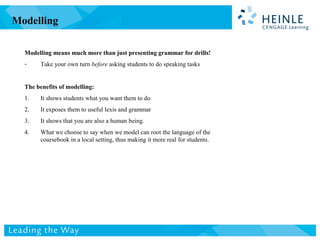Localise Global Coursebook
- 1. Localising the global coursebook Hugh Dellar The University of Westminster Heinle Cengage
- 2. • What problems do mass-market / global English language coursebooks pose for teachers in your context? • Have you found ways of tackling these problems? A warmer . . .
- 3. 1. The British Tourist Board approach - the great British breakfast - The Queen, Stratford-upon-Avon, Bath, etc. - Cheese rolling festivals! 2. The ‘anti-Imperialist’ backlash 3. The New Wave - retention of endlessly upbeat vision of the UK - coupled with facts and images from around the world Colonialism . . . and post-colonialism!
- 4. In attempting to be all things to all people, coursebooks end up being about nowhere, while Britain remains the default setting. Given this, how can teachers make students feel as if English relates to their own lives and realities? The way teachers deal with materials profoundly affects Ss.’ relationships with English. (1) The way we tackle vocabulary (2) The way we deal with speaking tasks (3) The way we approach texts are all crucial Finally, how ESSENTIAL attempts to address these issues. So what?
- 5. Teachers trump dictionaries! Teachers can choose to root explanations in either the national or local culture – or in the micro-culture of the class itself. A recent listening about tourism in Estonia contained the sentence: The food still leaves a bit to be desired - it tended to be quite stodgy and there wasn't a huge amount of choice, but otherwise, I certainly had nothing to complain about. Desired? “If something leaves a bit to be desired, it's not as good as you'd like it to be or as it should be. The English weather leaves a bit – or leaves something – to be desired!” “Your writing leaves a lot to be desired!” Vocabulary: the key to localised teaching!
- 6. Boardwork is crucial The food there a bit The weather here leaves something to be desired. Your writing a lot Now think of things in London / England – and in your hometown – that leave a bit to be desired. Monitor and turn student output into further board-based input. Public transport here leaves a lot to be desired. The trains are a……….! Half of them are falling to ………… . Plus, it's a r…..-…..! The cheapest tube ……… is four pounds! The media back home leaves a bit to be desired. We like to pretend it's free and ob…………., but we all know there's still a lot of c………… and certain things are t………. / off-l……… . Vocabulary: the key to localised teaching!
- 7. Time spent now is time saved later - longer examples make meanings clearer - they allow interaction with the class - they mean recycling of grammar and vocabulary come built-in - what students go away with in their notebooks is a record of the way the class negotiate the content of the coursebook. As such, these examples are more relevant and more memorable than language in coursebooks. Also makes it easier when students forget things. "You remember what we were saying about London transport? Or about Aziz's writing last week?” More is more!
- 8. Personalised questions are great warmers / revision activities • Can you think of any places you've been to that were a rip-off? Why? • Have you ever been to an ancient city or town? When? Where? What was it like? • How do you feel about censorship? • Have you heard any stories of things in your country being censored? What happened? • Is there anything you think is still a bit of a taboo subject in your country? These questions help Ss. transform the remote language of the coursebook in ways which word their very own worlds – and provide the teacher further opportunity to feed in more boardwork. Practice makes language more personal
- 9. Wayang puppets and the Ramayana Start from where the students are at
- 10. Modelling means much more than just presenting grammar for drills! - Take your own turn before asking students to do speaking tasks The benefits of modelling: 1. It shows students what you want them to do 2. It exposes them to useful lexis and grammar 3. It shows that you are also a human being. 4. What we choose to say when we model can root the language of the coursebook in a local setting, thus making it more real for students. Modelling
- 11. CUTTING EDGE Intermediate: Life stories A vocabulary exercise followed by personalisation task - find four things you’ve done already or were doing at the moment; four which you’d like to do one day; four you would NOT like to do and four you could do at any time in your lives. Then compare answers with a partner. Without modeling by the teacher, 'compare your answers' tasks can fall flat! OK. For example, for me . . . I went to university between 1988 and 1991. I did my degree IN English Literature At Goldsmiths College in New Cross, in south London. It's part of the University of London. Believe it or not, I graduated with a first-class degree, but to be honest, once I'd got my degree, I didn't really have much idea about what I wanted to do. I never went to university with a career plan in mind. I just did a degree that I found interesting. In fact, after I graduated, I started working – and my first job was making sandwiches in a factory in Plumstead, right out in Zone 5 in south-east London: I worked a twelve-hour day, doing really dull and monotonous work! The money was awful . . . and all the other people there made fun of me and called me The Professor! Modelling in action
- 12. In a sense, it’s an irrelevant distinction: both help bring the book to life However, here, modelling roots the impersonal language of the book in a geography that’s familiar to my students. These kinds of teacher-driven stories send subliminal messages: English is not just for talking about Britain and the British; it can also be a way for us to tell each other – and thus to tell the world – about OUR realities and our lives Personalised or localised?
- 13. All too often, texts are there to be ‘comprehended’ and processed for content – rather than responded to or related to the local environment. Texts should be vehicles for useful language, but also serve as points of comparison or departure. The addition of a few simple questions can facilitate this. SUPERVOLCANO: The Yellowstone National Park A classic factual ‘global knowledge’ text that leaves little room for our students! • What are the most famous natural features of your country? • Do you ever have to deal with any extreme weathers? • Have any natural disasters ever affected your hometown or country? While students chat, monitor and picking up on problem areas. Use their ideas for board-based input during your round-up stage, thus once again helping them to word their own worlds. Tailoring texts
- 14. Root coursebooks not only in the local culture, but also in the local language! Translate phrases, collocations and chunks – NOT single words or grammar. Translation validates L1, and also allows L1 to serve as a shortcut through which L2 can be re-accessed. Regular comparisons of L1 and L2 helps foster language awareness. Translation can be used in all manner of ways. It’s a great revision tool – using L1 translations to re-elicit chunks of L2 It's a great check of comprehension of new lexis – getting students to check translations in pairs and to discuss any differences. It can cast light on common recurrent errors that students are making. Localisation means local language!
- 15. 1. Taking non-natives seriously 2. Teaching can-do goals: making the global local 3. Plenty of personalised / localised questions 4. Translation as a built-in optional extra – vocab exercises / Language Patterns 5. The NATIVE SPEAKER ENGLISH feature Localisation – the ESSENTIALS















